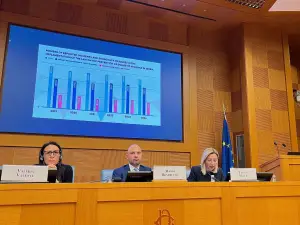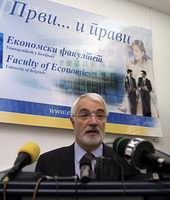- Serbia
Get to know Serbia
- Citizens
Culture and science
Health services
Pension and disability insurance
- Business
Employment
Economy
- Media
- Government
- Contact
Keep in touch
Contact form
Back
Keepin touch
Whether you have a question, comment, suggestion or any problem in the purview of the government, send us your message and we will try to respond as soon as possible. If your problem is not in our purview, we will forward your message to the relevant institution.
Q:
A:
Serbia to restore its credit rating soon, Deputy Prime Minister Labus says
Belgrade,
16 September 2004
Serbian Deputy Prime Minister Miroljub Labus said today he expects that Serbia will be granted credit rating with international financial institutions by December, enabling the country to seek out loans on the European market.
Participating at the counseling, entitled “Economic and Financial International Relations, Competitiveness of Economy and Exports” at the Belgrade University’s School of Economics, Labus said that the ability of the Serbian economy to borrow on the European market of capital will be possible thanks to the conclusion of the agreement with the London Club of Creditors.
He said that the Serbian economy’s top problems are foreign trade exchange and payment deficit, which totalled $1.83 billion in the January-July period, while the trade deficit amounted to around $3 billion.
According to him, although industrial production is reviving, it has not yet reached the levels from 1997 and 1999.
Labus said that this year will end with a gross domestic product (GDP) exceeding the projected 4 percent, most probably amounting to 7.5 percent. He also said that the growth of agricultural production will amount to between 10 and 12 percent.
Commenting on possible inflationary pressure, Labus pointed out that efforts have been made to end this year with a single-digit inflation rate, which would be a great contribution to economy’s development.
He said that the balance of payments deficit is the crucial problem of Serbia’s economy, adding that after the 2001 liberalisation of the market, the deficit grew steadily until September last year, when the Action Plan for harmonising Serbia and Montenegro’s economic systems was adopted. Growth accelerated after that, Labus explained. “The balance of payment did grow, but it wasn’t a sudden growth,” Labus went on to say.
According to him, the average customs fee was reduced from 15 percent to around 10 percent in 2001, and it amounts to around 6 percent now.
He said that the Serbian economy’s top problems are foreign trade exchange and payment deficit, which totalled $1.83 billion in the January-July period, while the trade deficit amounted to around $3 billion.
According to him, although industrial production is reviving, it has not yet reached the levels from 1997 and 1999.
Labus said that this year will end with a gross domestic product (GDP) exceeding the projected 4 percent, most probably amounting to 7.5 percent. He also said that the growth of agricultural production will amount to between 10 and 12 percent.
Commenting on possible inflationary pressure, Labus pointed out that efforts have been made to end this year with a single-digit inflation rate, which would be a great contribution to economy’s development.
He said that the balance of payments deficit is the crucial problem of Serbia’s economy, adding that after the 2001 liberalisation of the market, the deficit grew steadily until September last year, when the Action Plan for harmonising Serbia and Montenegro’s economic systems was adopted. Growth accelerated after that, Labus explained. “The balance of payment did grow, but it wasn’t a sudden growth,” Labus went on to say.
According to him, the average customs fee was reduced from 15 percent to around 10 percent in 2001, and it amounts to around 6 percent now.
-
 Belgrade, 21 November 2025
Belgrade, 21 November 2025Joint commitment to strengthen bilateral ties between Serbia, Botswana
-
 Belgrade/Rome, 21 November 2025
Belgrade/Rome, 21 November 2025Serbian government’s strong commitment to combating violence against women
-
 Belgrade, 18 November 2025
Belgrade, 18 November 2025Serbia remains committed to open dialogue, cooperation with OSCE
-
 Belgrade, 18 November 2025
Belgrade, 18 November 2025Cooperation with WHO to strengthen protection for victims of violence
-
 Belgrade, 18 November 2025
Belgrade, 18 November 2025Germany ready to accompany Serbia on its path towards EU
-
 Belgrade, 16 November 2025
Belgrade, 16 November 2025Solution for NIS must be found by next week
-
 Belgrade, 15 November 2025
Belgrade, 15 November 2025United States sends request for Russian ownership to exit NIS
-
 Belgrade, 13 November 2025
Belgrade, 13 November 2025Serbia continues to be reliable partner of EU
-
 Belgrade, 13 November 2025
Belgrade, 13 November 2025European integration, preserving peace, stability priorities for Serbia
-
 Belgrade, 13 November 2025
Belgrade, 13 November 2025Cooperation agreement signed for preparation of Specialised Expo 2027


